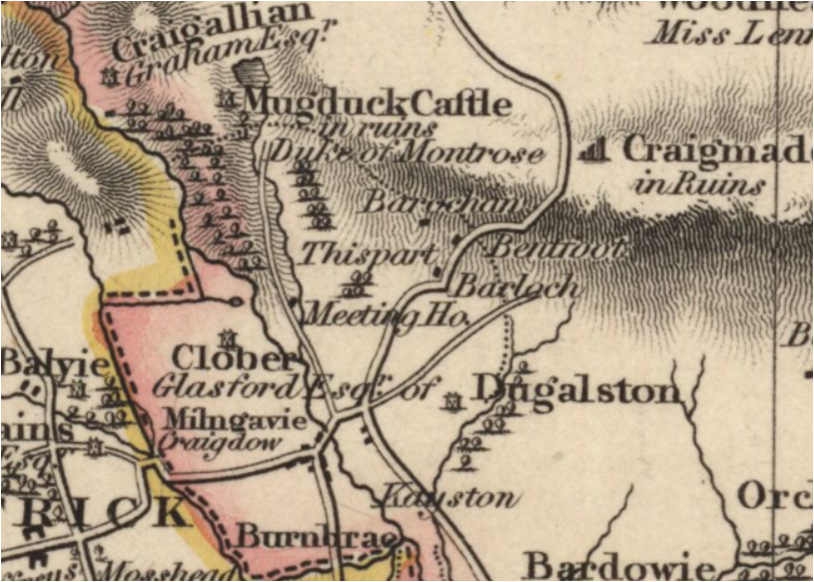Heatherbank House on:
[Wikipedia]
[Google]
[Amazon]
Heatherbank House is an early 19th century private house located in Milngavie, Scotland and is one of the oldest buildings in the town. It is the former site of the

 It is unclear when Heatherbank House was constructed. John Thomson's Atlas of Scotland (published 1832) clearly shows a building marked as a "Meeting House" in the location of the modern day house. Deeds show that the property/land was sold by
It is unclear when Heatherbank House was constructed. John Thomson's Atlas of Scotland (published 1832) clearly shows a building marked as a "Meeting House" in the location of the modern day house. Deeds show that the property/land was sold by
Heatherbank Museum of Social Work
The Heatherbank Museum of Social Work is part of the Glasgow Caledonian University in Scotland, and is believed to be the only museum dedicated to social work.
The museum was founded in the early Victorian house of Heatherbank, Milngavie in 1975 ...
.
History
Early history

 It is unclear when Heatherbank House was constructed. John Thomson's Atlas of Scotland (published 1832) clearly shows a building marked as a "Meeting House" in the location of the modern day house. Deeds show that the property/land was sold by
It is unclear when Heatherbank House was constructed. John Thomson's Atlas of Scotland (published 1832) clearly shows a building marked as a "Meeting House" in the location of the modern day house. Deeds show that the property/land was sold by James Burns (Scottish shipowner)
James Burns (9 June 1789 – 6 September 1871), was a shipowner born in Glasgow
Family
Burns was the third son of the Revd Dr John Burns (1744–1839), minister of the Barony parish of Glasgow, and his wife, Elizabeth, née Stevenson. His elde ...
to John Blackwood (bleacher) on 5 May 1838.
Links to the Milngavie Waterworks
In 1852 the engineerJohn Frederick Bateman
John Frederick La Trobe Bateman (30 May 1810 – 10 June 1889) was an English civil engineer whose work formed the basis of the modern United Kingdom water supply industry. For more than 50 years from 1835 he designed and constructed reser ...
was consulted by Glasgow Council in regard to its water supply. In 1854, on Bateman's advice, a bill was obtained to supply water to Glasgow from Loch Katrine. Alfred Moore (engineer) was appointed as his resident engineer and he purchased Heatherbank on 18 November 1856. Work had commenced on Mugdock Reservoir
Milngavie water treatment works (commonly known as The Waterworks) is a Scottish Water-operated water treatment facility located in Milngavie, Scotland. It is primary source of the water for the city of Glasgow (and the Greater Glasgow area) in w ...
in 1855 and the first section of the works were opened by Queen Victoria in October 1859, however Moore continued to reside at Heatherbank and continue his work until 1865.
The McNaughtan's and Australia
On 15 December 1865 Moore sold the property to Janet McNaughtan (née Blackwood), widow of the Reverend Alexander McNaughtan who was the local presbyterian minister. The Blackwood family had made some wealth owning the local bleachworks at Craigton. Janet resided in the house with 3 of her daughters; Jennie, Anne and Helen, until her death on 31 March 1875. Janet's son, Alexander McNaughtan (merchant), had left Scotland for Australia before the family moved to Heatherbank, however after the death of his wife he returned to the new family home. It is hypothesised by art researcher Stephen Scheding in his book "The National Picture" that Alexander McNaughtan may have been the last owner of Benjamin Duterrau's lost masterpiece, a large scale version of "The Conciliation". Scheding believed it was taken by Alexander McNaughtan to Heatherbank in 1869 however the picture has not been found. The painting depicts the conciliation of Tasmanian Aborigines by George Augustus Robinson. Scheding's visit to the house to search for the painting was well documented in local newspapers at the time. After the death of the final McNaughtan daughter in 1904 the house passed into the ownership of their nieces Agnes and Margaret Taylor.Later history
Heatherbank was purchased by architect Frank Fielden in December 1959 who gained some notoriety in Glasgow for designing the Refectory Building of the University of Glasgow, whilst also being a professor there. In 1975 he sold the property to Colin and Rosemary Harvey who opened theHeatherbank Museum of Social Work
The Heatherbank Museum of Social Work is part of the Glasgow Caledonian University in Scotland, and is believed to be the only museum dedicated to social work.
The museum was founded in the early Victorian house of Heatherbank, Milngavie in 1975 ...
on the premises. Heatherbank Press Publisher also operated out of the museum. After their deaths in 1993 the museum was moved to the Glasgow Caledonian University.
Modern day
The house was purchased in 1995 by Peter Mowforth and family. It underwent significant refurbishment works in 2012 which returned many of the period features that had been lost over the years.References
{{reflist Milngavie Historic houses Historic buildings and structures in Scotland